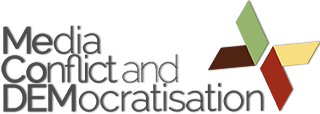What are the structural conditions of journalism in Egypt, Kenya, Serbia and South Africa?
For answers to this question please consult Judith Lohner‘s, Sandra Banjac‘s and Irene Neverla‘s analysis. It is now available per country and as a comprehensive report.
Download at: http://www.mecodem.eu/publications/working-papers
Executive Summary
Based on a multi-dimensional scheme as a conceptual framework, this working paper maps the structural conditions relevant to journalism and conflict communication in Egypt, Kenya, Serbia and South Africa, using a wide range of country-specific academic literature and reports compiled by various non-academic organisations active in the media sector.
- ‘Structural conditions’ are to be understood as the totality of (formal and informal) orders and structures that characterise media and journalism in a certain space, most commonly, a country.
- Eleven interrelated and interdependent dimensions of structural conditions relevant to media and journalism have been extracted and adapted from existing literature, guiding structured and comprehensive analysis within specific (country) contexts: (1) historical development, (2) political system, (3) political culture, (4) media freedom, (5) level of state control and regulation of media by the state, (6) media ownership and financing, (7) structure of media markets and patterns of information distribution, (8) orientation of media, (9) political/societal activity and parallelism of media, (10) journalism culture, and (11) journalistic professionalism.
- Country reports feature a unique set and combination of structural factors shaping media and journalism in the four countries, demonstrating the importance of conflict communication as a case study with regard to structural conditions. For example, different degrees of democratisation regarding media structures become evident in varying levels of media freedom and state interference in the media sector. Moreover, there are significant differences in media landscapes and the structure of media markets, reflecting the different size, economic situation, infrastructure and cultural, ethnic and linguistic diversity of the four countries, as well as the differing degrees of literacy and spending power of inhabitants.
- As to cross-national similarities, media and journalism face highly complex, ambivalent, contradictory and changing structural conditions in all four countries. These are shaped by the legacies of a non-democratic past, hybrid forms of political governance and a political culture which features a strong cleavage of ideologies and high level of clientelism. The constitutional guarantee of media freedom which exists in all countries is challenged by ambivalent or openly repressive media laws and a reluctance of governments to implement fundamental media reforms. Accordingly, the state plays an important role in the media sector, mirrored in political influence especially in the governance of (public/state) broadcasting and regulatory bodies, financing and interference in editorial decisions. Journalists in all four countries are likely to face pressures, harassment and the risk of prosecution, leading to a considerable gap between legal provision and the practice of media freedom. Furthermore, all countries are confronted not only with a relatively high level of media concentration but also with a considerable degree of political ownership. While the journalistic profession faces challenges regarding journalistic education and training, professional organisation and self-regulation, journalists in all four countries execute their jobs under precarious conditions, marked by professional insecurity, low salaries, as well a low professional status and fragile social reputation.
